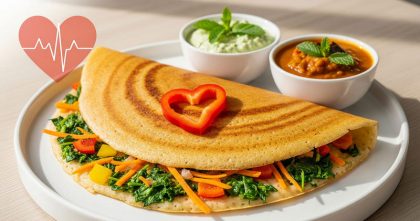Have you ever noticed how some people look thin in clothes but have a small pouch around their belly? This is particularly common among South Asians. You might have an uncle, aunt, or even see this in yourself – someone who doesn’t look overweight overall but carries fat around their midsection.
This phenomenon has a name in the medical community: “skinny fat.” And while it might seem like just a cosmetic concern, it can actually hide a serious health risk.
What is Visceral Fat?
Visceral fat is very different from the fat you can pinch with your fingers. Think of it this way:
Subcutaneous fat – This is the fat right under your skin that you can grab or pinch. It’s visible from the outside.
Visceral fat – This is fat that’s hidden deep inside your abdomen, wrapped around your vital organs like your liver, pancreas, and intestines. You can’t see or feel it from the outside.
![Illustration of visceral fat vs subcutaneous fat]
Imagine your organs are like valuable items in a storage box, and visceral fat is like bubble wrap surrounding them. A little protection is good, but too much bubble wrap makes everything function poorly and can damage what’s inside.
Why South Asians Need to Pay Special Attention
South Asians (people from India, Pakistan, Bangladesh, Sri Lanka, and Nepal) have a unique body composition that puts them at higher risk for visceral fat problems, even when they appear thin. Research has found that:
- The “Skinny-Fat” Phenomenon: South Asians often have higher body fat percentages at lower body weights compared to other ethnic groups. You might look slim but actually have unhealthy levels of fat hidden inside your body.
- Lower Muscle Mass: Studies show South Asians typically have less muscle mass than Europeans with the same BMI (body mass index). Less muscle means a higher percentage of your body is fat.
- Different Fat Distribution: South Asians tend to store more fat around their organs and in their abdomen rather than evenly throughout the body.
- Earlier Health Risks: Because of these factors, South Asians often develop health problems like diabetes and heart disease at lower weights than other groups.
This combination of factors has been termed the “Asian-Indian Phenotype” or “thin-fat phenotype” by researchers.
Why is Visceral Fat Dangerous?
Visceral fat isn’t just extra weight – it’s metabolically active tissue that releases harmful substances into your body. Here’s why it’s particularly dangerous:
- It causes inflammation – Visceral fat releases inflammatory chemicals that can damage your body over time.
- It affects your insulin – It makes your body resistant to insulin, which can lead to diabetes. South Asians already have higher rates of diabetes, and visceral fat makes this worse.
- It harms your heart – Visceral fat increases your risk of heart disease and stroke by raising bad cholesterol and blood pressure. Heart disease is already the #1 killer among South Asians.
- It affects many organs – Because it’s wrapped around your organs, visceral fat can impact liver function, digestive health, and more.
Even people who look thin can have dangerous levels of visceral fat – that’s what makes it so tricky and why it’s sometimes called “hidden fat.”
How to Know if You Have Too Much Visceral Fat
Without expensive medical scans, you can’t measure visceral fat precisely. However, there are some simple ways to estimate if you might have too much:
- Measure your waist:
- For South Asian men: A waist size of 35 inches (90 cm) or more indicates excess visceral fat
- For South Asian women: A waist size of 31.5 inches (80 cm) or more indicates excess visceral fat
- These cutoffs are lower than for other ethnic groups because South Asians face health risks at lower thresholds.
- Calculate your waist-to-height ratio:
- Measure your waist (at belly button level)
- Divide by your height
- If the result is more than 0.5, you likely have excess visceral fat
- Look at your body shape:
- If you have an “apple shape” with weight around your middle rather than your hips and thighs, you likely have more visceral fat.
- Check for risk factors:
- Do you have high blood pressure, high blood sugar, or high triglycerides?
- Do you have a family history of early heart disease or diabetes?
- These can be signs of visceral fat-related problems.
Remember, even if you look thin in clothes but have a small belly pouch, you could still have unhealthy levels of visceral fat.
How to Reduce Visceral Fat
The good news is that visceral fat responds well to lifestyle changes. Here are effective strategies:
1. Adjust Your Diet
- Reduce refined carbohydrates – Traditional South Asian diets can be high in white rice, roti, and sweets. Try replacing some of these with:
- Brown rice instead of white
- More vegetables and proteins
- Smaller portions of starchy foods
- Increase protein intake – Many South Asian vegetarian diets may not have enough protein. Consider adding:
- More dal varieties
- Low-fat dairy like paneer or yogurt
- Plant proteins like tofu or soya products
- Choose healthy fats – Replace ghee and coconut oil (sometimes) with:
- Olive oil
- Mustard oil
- Nuts and seeds
2. Get Moving
Physical activity is extremely effective for reducing visceral fat. South Asians are often less physically active than other groups, which contributes to the problem.
- Start with just 30 minutes of moderate exercise 5 days a week
- Add strength training to build muscle mass
- Try walking after meals to improve blood sugar control
- Consider dance forms like Bhangra or garba that are fun and effective
3. Manage Stress
Stress increases cortisol levels, which can promote visceral fat storage.
- Practice meditation or yoga
- Get adequate sleep
- Maintain social connections
- Find healthy ways to relax
Success Story: Priya’s Journey
Priya, a 42-year-old software engineer, always considered herself “naturally thin.” She wore size small clothes but noticed a small pounch around her middle that wouldn’t go away. After experiencing unexplained fatigue, she saw her doctor and was shocked to learn her blood sugar was in the pre-diabetic range.
Her doctor explained that despite her slim appearance, she had excess visceral fat around her organs. Priya made three key changes:
- She replaced her large portions of white rice with smaller servings of brown rice and more vegetables
- She started walking for 30 minutes each evening after dinner
- She added 10 minutes of morning yoga to reduce stress
Within six months, her waist measurement decreased by 2 inches, her energy improved, and her blood sugar returned to normal levels. The visceral fat that had been threatening her health was reduced, even though her weight only changed by a few pounds.
Take Action Today
Remember, visceral fat can be dangerous even if you don’t “look fat.” As South Asians, we need to be especially vigilant about this hidden risk.
Start with one small change today:
- Measure your waist to know where you stand
- Add a 10-minute walk to your daily routine
- Replace one refined carbohydrate portion with vegetables
Your organs will thank you, and you’ll be taking an important step toward preventing serious health problems like diabetes and heart disease that affect our community at high rates.
References
- Sniderman, A.D., et al. (2007). “Why might South Asians be so susceptible to central obesity and its atherogenic consequences? The adipose tissue overflow hypothesis.” International Journal of Epidemiology, 36(1), 220-225. Link
- Cleveland Clinic. (2023). “Visceral Fat: What It is & How to Get Rid of It.” Link
- WebMD. (2024). “Visceral Fat: Why It’s Dangerous and How to Lose It.” Link
- Miller, M.R., et al. (2022). “Liver, visceral and subcutaneous fat in men and women of South Asian and white European descent: a systematic review and meta-analysis.” Diabetologia. Link
- Maheshwari, A. (2024). “Weight Loss and Weight Management for South Asians.” Link
- Luxembourg Institute of Health. (2022). “Visceral Fat Calculator.” Link
- Health Direct Australia. (n.d.). “How to reduce visceral body fat (hidden fat).” Link
- Misra, A., et al. (2019). “The Metabolic Syndrome in South Asians: Epidemiology, Determinants, and Prevention.” Metabolic Syndrome and Related Disorders.




